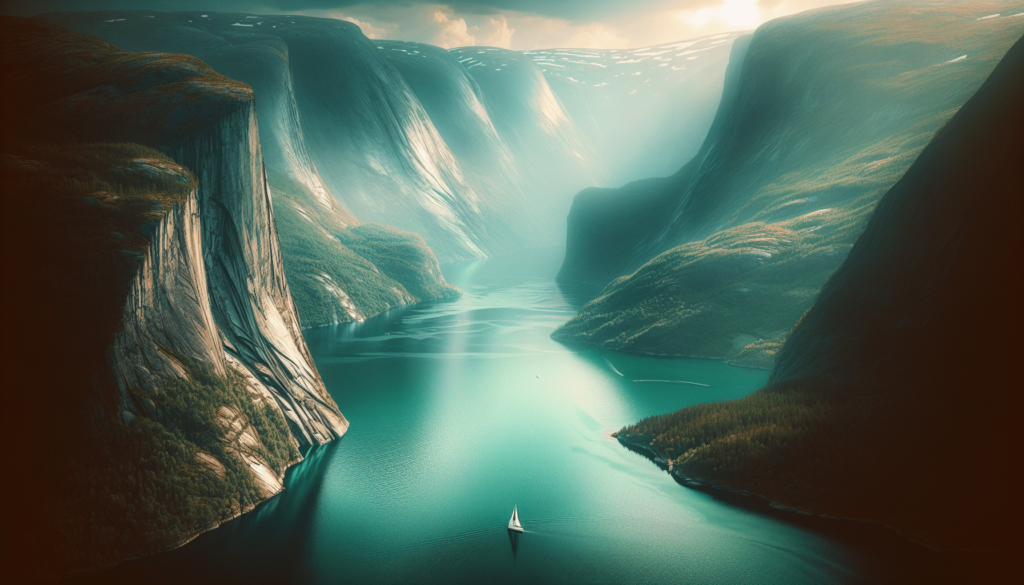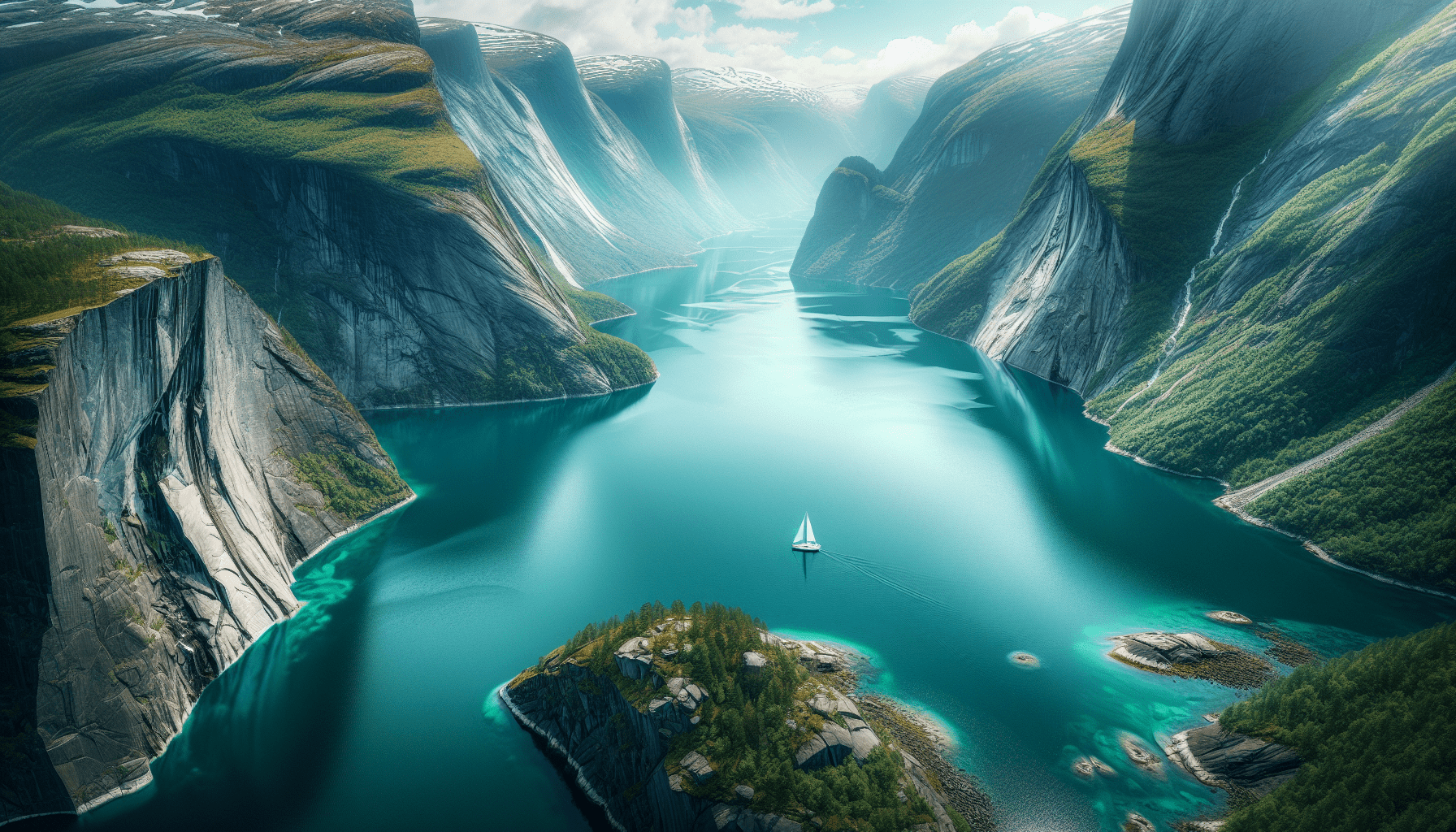Imagine sailing through stunning landscapes of towering mountains, crystal clear waters, and cascading waterfalls. Picture yourself surrounded by the serene beauty of nature, with the refreshing breeze gently caressing your face. Now, take this unforgettable journey to the majestic fjords of Norway. Embark on an adventure of a lifetime as you explore these breathtaking natural wonders, immersing yourself in their awe-inspiring grandeur and discovering the hidden gems nestled within their depths. From the world-famous Geirangerfjord to the lesser-known Nærøyfjord, prepare to be captivated by the sheer beauty and tranquility that await you in this land of timeless beauty.
Geography of Norway
The fjords of Norway
Norway is renowned for its stunning fjords, which are long, narrow inlets carved by ancient glaciers. These beautiful natural formations stretch along the country’s rugged coastline, offering breathtaking views and unique landscapes. Fjords are characterized by steep cliffs, deep blue waters, and lush green valleys. Their formation is a result of glacial activity over thousands of years, and they showcase the awe-inspiring power of nature.
Location and size of the fjords
The fjords of Norway are located on the western coast of the country. These deep, elongated valleys extend from the coast into the interior, creating a network of waterways that stretch for around 1,190 miles in total. Some of the largest fjords in Norway include the Sognefjord, Hardangerfjord, Geirangerfjord, and Nordfjord. Each fjord has its own unique characteristics, making exploring them a truly remarkable experience.
History of the Fjords
Formation of the fjords
The formation of the fjords is a result of geological processes that took place over millions of years. During the last ice age, massive glaciers flowed through the valleys, eroding the surrounding rock and creating deep, U-shaped troughs. As the climate warmed and the glaciers retreated, these valleys were gradually flooded by the rising sea levels, resulting in the fjords we see today.
Glacial activity
The fjords bear witness to the immense power of glaciers. These giant rivers of ice shaped the land, carving out the steep walls and creating the unique geological features that are characteristic of fjords. Glacial activity continues to play a role in shaping the fjords, with the ice constantly moving and carving away at the landscape. The combination of ice, water, and rock creates a mesmerizing environment that captivates visitors from around the world.
Human settlements in the fjords
For centuries, humans have been drawn to the fjords for their natural beauty and abundant resources. Ancient settlements along the fjords date back thousands of years, with evidence of early human presence found in archaeological sites. Fishing has long been a way of life for the coastal communities, and the fjords provided a means of transportation and trade. Today, many towns and villages dot the fjords, offering glimpses into the rich history and traditions of the region.

Popular Fjords to Explore
Geirangerfjord
One of the most famous and picturesque fjords in Norway, Geirangerfjord, is a UNESCO World Heritage site. Known for its dramatic cliffs, cascading waterfalls, and serene blue waters, this fjord is a must-visit for nature enthusiasts. The Seven Sisters waterfall and the Bridal Veil waterfall are iconic landmarks of Geirangerfjord, creating a mesmerizing backdrop for visitors as they cruise or kayak through its waters.
Sognefjord
Sognefjord is the longest and deepest fjord in Norway, stretching over 127 miles inland. This enchanting fjord offers a blend of stunning natural beauty and cultural heritage. The Nærøyfjord, a branch of Sognefjord, is recognized as a UNESCO World Heritage site and is known for its narrow passage surrounded by towering cliffs. The charming villages along Sognefjord, such as Balestrand and Flåm, provide an opportunity to immerse yourself in Norwegian culture.
Hardangerfjord
With its idyllic orchards, vibrant blossoms, and snow-capped mountains, Hardangerfjord is a paradise for nature lovers. This fjord is famous for its fruit blossoms in the spring, with apple and cherry orchards covering the hillsides. Visitors can explore the picturesque towns of Odda and Eidfjord, hike to the stunning viewpoint of Trolltunga, or simply relax and take in the breathtaking scenery.
Nordfjord
Nordfjord offers a diverse range of landscapes, from peaceful valleys to rugged mountains and towering glaciers. The Jostedalsbreen National Park, home to mainland Europe’s largest glacier, is located in Nordfjord. Visitors can embark on glacier hiking expeditions, explore charming coastal villages like Måløy and Selje, or simply enjoy the tranquility of this unspoiled wilderness.
Lysefjord
Known for its sheer cliffs and iconic natural landmarks, Lysefjord is a sight to behold. The Preikestolen, or Pulpit Rock, is a popular destination for hikers, offering panoramic views of the fjord from its 2,000-foot-high perch. The Kjerag mountain, with its famous Kjeragbolten boulder wedged between two cliffs, is another iconic attraction. For those seeking an adrenaline rush, base jumping from the cliffs of Lysefjord is a thrilling option.
Unique Features of Norwegian Fjords
Steep cliffs
One of the most striking features of Norwegian fjords is the steepness of their cliffs. Towering above the water, these majestic cliffs create a sense of awe and wonder. The sheer rock faces, often reaching heights of several hundred meters, provide a dramatic backdrop against the tranquil blue waters of the fjords.
Waterfalls
Norwegian fjords are renowned for their numerous waterfalls, cascading down the cliffs and adding to the natural beauty of the surroundings. Whether it’s the famous Seven Sisters waterfall in Geirangerfjord or the thundering Kjosfossen waterfall along the Flåm Railway, the sight and sound of these majestic falls are truly unforgettable.
Narrow passages
Many of the fjords in Norway feature narrow passages that cut through the landscape, creating a sense of adventure and exploration. These narrow channels, often flanked by towering cliffs, offer a unique perspective and a feeling of being immersed in nature. Navigating through these passages by boat or kayak is an exhilarating experience.
Snow-capped peaks
The Norwegian fjords are characterized by their proximity to majestic snow-capped peaks. These towering mountains, often reaching heights of over 6,500 feet, provide a stunning contrast to the deep blue waters of the fjords. The combination of the rugged mountains, the sparkling fjords, and the clear blue skies creates a landscape that is unmatched in its beauty.
Flora and fauna
The fjords of Norway are home to a rich and diverse array of flora and fauna. The lush green valleys and fertile soils support a variety of plant life, ranging from vibrant wildflowers to dense forests. In the fjords, you may encounter a wide range of bird species, including sea eagles, puffins, and cormorants. You may even catch a glimpse of seals, porpoises, or whales swimming in the deep waters.

Activities and Attractions
Fjord cruises
Taking a cruise on the fjords is one of the best ways to explore their beauty and grandeur. Numerous cruise operators offer guided tours, allowing you to relax and soak in the stunning scenery. Whether you choose a leisurely day cruise or an overnight adventure, you’ll have the opportunity to witness the fjords from a different perspective and marvel at their majestic splendor.
Kayaking and canoeing
For a more active and immersive experience, kayaking and canoeing provide an exhilarating way to explore the fjords. Paddling along the calm waters, you’ll have the freedom to venture into narrow passages and get up close to waterfalls and wildlife. Guided tours are available for those who are new to kayaking, ensuring a safe and enjoyable experience.
Hiking and trekking
Norway is a hiker’s paradise, and the fjords offer a multitude of hiking and trekking opportunities. There are trails suitable for all skill levels, from easy strolls along the water’s edge to challenging multi-day hikes in the high mountains. Some of the most iconic hikes include the Trolltunga and the Pulpit Rock, where you’ll be rewarded with breathtaking views of the fjords and surrounding landscapes.
Fishing
Fishing is deeply ingrained in Norwegian culture, and the fjords provide ample opportunities for anglers to cast their lines. Whether you prefer freshwater or saltwater fishing, there are abundant fish species to be found, including trout, salmon, cod, and halibut. Some fjords also offer deep-sea fishing excursions, giving you the chance to catch larger prey while enjoying the stunning scenery.
Visiting charming villages
The fjords are dotted with picturesque villages that exude charm and tranquility. These small communities offer a glimpse into traditional Norwegian life and provide a warm and welcoming atmosphere. Strolling through the narrow streets, you’ll discover unique shops, cozy cafes, and quaint museums. Engaging with the locals and learning about their way of life adds depth and authenticity to your fjord exploration.
Best Time to Visit
Summer season (June to August)
The summer season is one of the most popular times to visit the Norwegian fjords. During these months, the weather is generally mild, with temperatures ranging from 60°F to 75°F. The long daylight hours allow for more time to explore and soak in the beauty of the fjords. The summer months also coincide with the peak tourist season, so it’s advisable to book accommodations and activities in advance.
Midnight sun
If you’re seeking a truly unique experience, consider visiting the Norwegian fjords during the midnight sun period. In the far north, from late May to mid-July, the sun never sets below the horizon, creating a phenomenon known as the midnight sun. This natural phenomenon bathes the fjords in a soft, golden light, providing a surreal and magical atmosphere.
Off-season benefits
Visiting the fjords during the off-season has its own set of advantages. The crowds are smaller, allowing for a more peaceful and intimate experience with nature. Additionally, accommodation and transportation prices may be lower, making it more affordable to explore the fjords. The off-season, typically in spring and fall, holds its own beauty, with blossoming flowers, vibrant foliage, and a quieter ambiance.
How to Get There
International airports in Norway
Norway has numerous international airports that serve as gateways to the fjords. The main international airports include Oslo Airport Gardermoen, Bergen Airport Flesland, and Stavanger Airport Sola. These airports are well connected to major cities around the world, making it convenient to reach the fjords.
Domestic transportation options
Once in Norway, there are various options for traveling to the fjords. Public transportation, such as trains and buses, connects major cities to the fjord regions. The train services in Norway are known for their scenic routes, providing an opportunity to admire the picturesque landscapes along the way. Renting a car is also a popular option, as it allows for greater flexibility and the chance to explore off-the-beaten-path destinations.
Ferry services
Ferry services are an integral part of the transportation network in Norway, particularly for navigating the fjords. Ferries operate between various towns and villages along the fjords, offering a unique and scenic way to travel. Some ferries also provide the option of bringing your car on board, allowing you to easily explore different parts of the fjords at your own pace.
Cruise options
For those looking for a more leisurely and all-inclusive experience, cruises are a popular choice. Numerous cruise lines offer fjord cruises, departing from major Norwegian cities such as Bergen or Oslo. These cruises provide the opportunity to explore multiple fjords, visit charming villages, and enjoy onboard amenities and entertainment.
Accommodation Options
Hotels and resorts
Norway offers a range of hotels and resorts to suit every preference and budget. From luxury hotels with panoramic fjord views to cozy boutique accommodations, there is something for everyone. Many hotels are nestled in scenic locations, providing the perfect base for exploring the surrounding fjord landscapes. Some resorts even offer spa facilities and outdoor activities, ensuring a relaxing and rejuvenating experience.
Camping sites
For those seeking a closer connection with nature, camping is a popular option in Norway. The country has a network of well-maintained campgrounds, some of which are located near the fjords. Camping allows you to immerse yourself in the tranquility of the fjord environment, waking up to stunning views and the sounds of nature.
Renting cabins and cottages
To truly experience the charm and coziness of Norwegian life, consider renting a cabin or cottage. These traditional accommodations are often situated along the fjords, offering unparalleled access to nature. Whether it’s a rustic log cabin or a modern cottage with all the amenities, staying in a self-catering accommodation allows for a comfortable and authentic experience.
Local Cuisine and Dining
Seafood delicacies
Norwegian cuisine is known for its emphasis on seafood, and the fjords provide a bountiful supply of fresh fish and shellfish. From smoked salmon and trout to delicacies like king crab and scallops, seafood lovers will be in paradise. Try traditional dishes like “lutefisk” (dried cod soaked in lye) or “rakfisk” (fermented fish) for a taste of local flavors.
Traditional Norwegian dishes
In addition to seafood, Norwegian cuisine features hearty and comforting dishes that are perfect for fueling your fjord explorations. “Fårikål” (lamb stew), “klippfisk” (salted and dried cod), and “lefse” (thin potato flatbread) are just a few examples of traditional Norwegian dishes. Pair them with local cheeses, such as gjetost, and you’ll have a memorable culinary experience.
Cosy cafes and restaurants
The fjord regions are dotted with charming cafes and restaurants where you can relax and indulge in delicious food. Enjoy a cup of locally roasted coffee or hot chocolate while taking in the panoramic fjord views. Sample freshly baked pastries like “kanelboller” (cinnamon buns) or try traditional Norwegian desserts like “tilslørte bondepiker” (layered apple dessert).
Tips for Exploring the Fjords
Dress appropriately
The weather in Norway can be unpredictable, even during the summer months. It’s important to dress in layers and be prepared for changing conditions. Bring waterproof and windproof outerwear, as well as sturdy hiking shoes. Don’t forget to pack a hat, gloves, and sunglasses to protect yourself from the sun, wind, and cold.
Carry essential gear
When venturing into the fjords, it’s essential to have the right gear. If you plan on hiking, bring a backpack with water, snacks, a map, and a compass. A waterproof camera or a smartphone with water-resistant features will allow you to capture the beauty of the fjords without worrying about damage. Binoculars are also handy for spotting wildlife and taking in distant views.
Respect the environment
Norway takes great pride in its pristine natural environment, and it’s important to respect and preserve this beauty. Follow the principles of “Leave No Trace,” disposing of waste properly and avoiding damage to vegetation and wildlife. Stay on marked trails and respect any restrictions or regulations in place to protect the fragile ecosystem of the fjords.
Learn about local customs
Immerse yourself in the local culture and customs of the fjord regions. Norwegians are known for their friendliness and hospitality, so take the time to engage with the locals. Learn a few basic Norwegian phrases, such as “takk” (thank you) and “hei” (hello), to show your appreciation and respect. Familiarize yourself with local customs, such as removing your shoes when entering someone’s home or cabin.
Be prepared for changing weather
Weather conditions in the fjords can change rapidly, even within the span of a few hours. It’s important to keep an eye on the forecast and be prepared for rain, wind, or sudden temperature drops. Dress in layers, carry a waterproof jacket, and be flexible with your plans in case you need to adjust to changing weather conditions.
Conclusion
The fjords of Norway are a testament to the captivating beauty and power of nature. From the towering cliffs to the majestic waterfalls, each fjord offers a unique and awe-inspiring experience. Whether you choose to explore by boat, kayak, or on foot, the fjords will leave you mesmerized by their grandeur. So, pack your bags, immerse yourself in the stunning landscapes, and embark on a journey to explore the majestic fjords of Norway.

